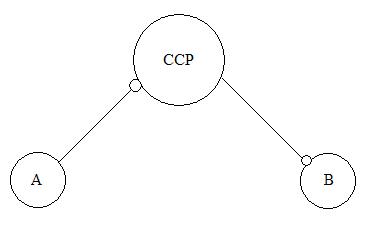"May 16 2009, 10:00 am
How NPR Mangled Geithner's Plan For OTC Derivatives
Timothy Geithner has released his proposal on how to regulate the OTC derivatives market. The proposal is broad in its scope and the regulations proposed would have a profound impact on market practice if implemented. Despite this, the sleuths at NPR claim to have discovered a "huge loophole" in the plan. I've also been studying both Geithner's proposal and the NPR article on the subject, and the only holes that I found were in NPR's understanding of the OTC market. In order to fully understand the earthly implications of Geithner's policies and the gargantuan errors made on Planet Money, we should probably understand what the OTC derivatives market is. So, let's begin with a brief overview of what the OTC market is and what it isn't.- Banks and other players have to tell the government when they buy and sell these derivatives. That means the government can know how many are out there and who has them.
- If banks and others are buying and selling standardized derivatives, they must trade them on an exchange, sort of like how stocks are traded on an exchange. That way it's more transparent and the prices should more accurately reflect the market sentiment.
- But -- and here's the big but -- banks and others are perfectly free to continue trading custom-made derivatives as private transactions between two parties.In case you didn't catch it, that last part was supposed to be the clincher. But before we can appreciate why it's not a clincher, we need to do a bit more homework on the OTC market. In Geithner's proposal, there's a lot of talk about CCPs, or "central counterparties." These are often incorrectly equated with exchanges. CCPs are not exchanges. They are exactly what their name suggests: a central counterparty for swaps of a particular type. After two parties enter into an OTC trade together, they novate, or more colloquially, move their trades to the CCP. So unlike trades executed on an exchange, CCP trades are entered into directly between the two parties, but later shifted over to the CCP. There are a lot of reasons why this is done, and they're beyond the scope of this article. But if you're interested in reading more about CCPs, go here. The key take-away is that CCPs are not exchanges, but more like risk repository/management systems where trades get moved to after they're executed.
[I]f an OTC derivative is accepted for clearing by one or more fully regulated CCPs, it should create a presumption that it is a standardized contract and thus required to be cleared.
[A]ll trades not cleared by CCPs [are] to be reported to a regulated trade repository.This is in contrast to NPR's second point above, which asserts that all such trades would be traded on an exchange. That is wrong. What this says is: all trades that can be moved to a CCP (not an exchange) should be, and it will be assumed that this is required; and if they're not moved to a CCP, they have to be recorded in a trade repository. So, by definition, this proposal would make regulators aware of every single trade in the OTC market since every trade is either on a CCP, in which case the CCP will record its existence, or not on a CCP, in which case the trade repository will record its existence. But how do we explain NPR's blunder in their third point? That blunder comes from yet another equivocation between a CCP and an exchange. The relevant language from Geithner's proposal is as follows:
[Relevant laws should be amended to impose] the encouragement of regulated institutions to make greater use of regulated exchange-traded derivatives.NPR hones in on the "encourage" language, taking this to mean that market participants will have a choice between using an exchange or being unregulated financial pirates. Of course, those swashbuckling financiers will choose the latter. As I'm sure you're starting to see, this is a false dilemma. What Geithner is suggesting here is that regulated institutions avoid the OTC market altogether, and make use of derivatives from the first category above (the exchange traded ones). Of course, such a policy should be suggestive and not prescriptive, because contrary to popular belief, OTC products serve legitimate needs that exchange traded products don't meet, at least not yet.
It seems reasonable to expect that every single sales team on Wall Street will work very hard to convince their customers that they have Very Special, One-Of-A-Kind Credit Derivatives that are far better than the boring old ones traded on the exchange.Unfortunately for NPR, this is complete nonsense. The vast majority of credit default swaps are completely standardized and have been for a while. Recent changes to how CDS are priced has increased fungibility even further. In fact, one of NPR's commenters actually pointed this out. The NPR commenter writes:
Virtually ALL CDS contracts are standardized. Which is to say that I can open a position with Goldman Sachs and unwind that position at Citigroup. These instruments will be covered under the Obama proposal and are well suited to being exchange traded. Are there bespoke products available in the derivative market place? Absolutely. But they account for a minuscule portion of the overall business.But NPR doesn't stop there. Acknowledging the possibility (fact) that they are wrong about standardized CDS, they go on to claim that:
[Even assuming the commenter] is right (he probably is) and most currently-traded CDS would qualify for a new exchange or clearinghouse; it seems fair to guess that lots of CDS operations will be looking for ways to avoid that clearinghouse and all the extra regulation and transparency and lowered commissions it brings with it.Yet again, unfortunately for NPR, that is more nonsense. The major swap dealers have already set up a CCP on their own, before regulators required them to do so, and are currently moving trades to it. Swap dealers do not make money by over-complicating products and duping trillions of dollars worth of capital. They make money by creating a market. That is, they buy and sell swaps, creating a market, and pocket the difference between the prices at which they buy and sell. If you want to use jargon, you would say they create "liquidity" for swaps. That's their business. Making complicated products that aren't fungible does not advance that business model. Even more importantly, as we noted above, Geithner's proposal wouldn't let them off the hook simply because they used bespoke products. If the trade is accepted on a CCP, it is presumed to be required to go there. And even if it's not, it gets reported anyway.
From Derivative Dribble:
"Rethinking Central CDS Counterparties In Uncategorized on May 5, 2009 at 7:45 am
Also published on Cluster Stock
Regulators have been largely supportive of the credit default swap market’s efforts to move all standard CDS (a.k.a. “vanilla” CDS) contracts onto a central counterparty (CCP). Within a relatively short amount of time, the CDS market garnered the support of both the SEC and the Federal Reserve, setup shop, and executed CDS transactions totaling $71 billion in notional amount on ICE Trust LLC (ICE), the first of what could be a handful of CCPs. Given that the CDS market is still serving time on the pillory, this kind regulatory largess seems to imply that a CCP must undoubtedly be a good thing. However, not everyone is convinced. In a recent paper, Darrell Duffie and Haoxiang Zhu of Standford University described the state of affairs with and without a CCP in mathematical terms, proposed a measure of efficiency which they use as a proxy for counterparty risk, applied this measure to each state of affairs, and came to conclusions that are surprising, but not counterintuitive once you take a moment to consider the trade-offs between a distributed dealer system and a CCP.
There are two central points in their paper: (1) the benefits of having a CCP compared to not having a CCP (the distributed dealer system) is a function of the number of dealers (i.e., the more dealers, the more the system benefits from having a CCP) and that the current number of CDS dealers might be too small to realize any benefits from a CCP; and (2) even if having a single CCP is more efficient than not having one, having more than one CCP is never more efficient than having none at all. The assumption underlying these two points is that having a CCP as opposed to not having a CCP is in essence a choice between (i) multilateral netting across a single asset class and (ii) bilateral netting across multiple asset classes. After a bit of back and forth with Duffie, I agree that this is the case, but only in the short term. That is, there is nothing about a CCP that precludes netting across asset classes, even if the current model doesn’t facilitate it. I also disagree with the two central conclusions, mostly due to shortcomings of the model that the authors acknowledge in their paper. Specifically, they acknowledge that their model doesn’t deal with so called “knock-on effects,” or simply put, how one dealer default can lead to another. I also disagree with how Duffie and Zhu measure the benefits of netting, but we’ll spare our brains the heavy lifting and focus on the more practical issues. In this article, I’ll focus on explaining why a CCP does not preclude netting across asset classes. In a follow up article, I’ll explain how a CCP mitigates counterparty risk by facilitating trade compression.
What Is A Central Counterparty?
Rather than provide a one line, academic definition, I’ll proceed gradually, and by way of example. For starters, a CCP is not an exchange. Even with a CCP, inter-dealer trades will still be entered into between dealers, and price discovery will still take place across dealers. That is, dealers will still trade with each other, at least initially. After two dealers enter into a CDS trade, they will transfer, or “novate” their positions to the CCP. For example, in the prototypical CCP transaction, if Dealer A sells protection to Dealer B, each dealer would then novate its position to the CCP. After the novation, the state of affairs is such that A sells protection to the CCP and the CCP sells protection to B. When payments are made on the CDS, they get made to the CCP and then passed on to the parties.

At first blush, it might seem like all we’ve done is throw an extraneous and useless 3rd party into the transaction that does little more than operate as a conduit. However, this is not the case. The CCP is a distinct entity that has an interest in its own survival, and since the CCP is now liable to both dealers, it has an interest in being well-capitalized. While individual dealers also have an interest in being well-capitalized, they are unable to determine whether the CDS market as a whole is well-capitalized. And even if they were able to determine whether or not that is the case, each individual dealer has no power to convince others to increase the capital allocated to their positions. By centralizing all of the trade information into one entity and giving that entity control over the levels of collateral that dealers must post, we have created a method through which we can better ensure the adequate capitalization of the entire CDS market. For example, if one dealer is unable to fully collateralize its positions, the CCP can draw on its own capital and the capital of the other dealers to make up for the shortage. Without a CCP, that shortage of collateral would probably trigger events of default, which could “knock-on,” or cascade through the market. But as always, there’s no free lunch, and despite all of this upside, we have also concentrated the risk of counterparty failure.
Payment Netting And Payment Settlement
As Duffie and Zhu note, dealers net their payments and collateral across different types of vanilla swaps. So, for example, if Dealer A owed Dealer B $5 under a vanilla interest rate swap on some payment date, while Dealer B owed Dealer A $3 under a vanilla CDS, A would simply pay B $2. This type of bilateral netting across asset classes reduces the risk that dealers will default when compared to not having such netting because it reduces the total amount of cash that is needed to meet payment obligations. Duffie and Zhu argue that because CCPs segregate vanilla CDS trades from all other types of vanilla swaps, we miss the opportunity to net across asset classes. This is not necessarily the case.
First, we need to distinguish between the entities that are liable for the trades (i.e., the dealers and the CCP) and the entities that actually process the trade information and payments. In the case of ICE, trade information is processed by both TCC and DTCC. After that trade information gets processed, DTCC submits payment instructions to CLS Bank, which actually handles the payments. So, the CCP itself is not able to net payments across various asset classes, since it only handles CDS trades and moreover doesn’t actually settle the payments. However, DTCC will submit payment instructions to a settlement agent, CLS Bank, that actually handles the cash payments. CLS Bank could also receive payment instructions for other asset classes from the dealers (i.e., payment instructions on interest rate swaps, etc.) and net the payment instructions from the DTCC against the payment instructions from the dealers’ other activities. In fact, CLS Bank is also a leading settlement agent in the FX market.
In short, netting CDS contracts first does not preclude you from netting against other swaps later, especially since trading and settlement are handled by distinct entities."







































No comments:
Post a Comment